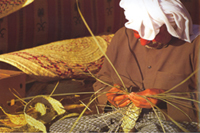
n Hadramout palm tree baskets are used mainly to keep dates from spoiling when they are still on the trees, i.e. before they are harvested. This process is called Qunamah" in which these baskets are installed in the palm trees to keep dates in good condition.www. Yemen-handicraft.com www. Yemen-handicraft.com The Hadrami culture is very rich and includes various aspects that are linked to business and trade. Many of the trades and trade routes go back centuries and are still very much alive today. Using palm leaves to manufacture baskets and other objects is still popular in Hadramout despite the availability of metal and plastic utensils all around. Al-Khus, or Al-Shataf (products from palm leaves), is considered one of the traditional handicrafts in Yemen, particularly in the regions where palm trees are available such as Wadi Hadramout. Thanks to the significance of this popular art, a lot of centers were established in order to maintain such handcrafts and protect them from man-made actions that affect nature. This is particularly given that human beings represent one of the leading causes of environmental devastation. In the past, Al-Khus was a daily necessity, as women could meet most of their household needs from its products in its different forms. This handicraft is also called the "date industry" since all tools used in this art are taken from palm trees that produce dates. Arabs called this handicraft "Khuwasah," which means using palm leaves to make products. The handicraft still exists in different parts of Yemen and its availability and quality differ from one region to another based on the availability of palm trees. Among the areas that still preserve this art are Sayoun, Tarim, Taris, Sah, Madudah, Al-Hutah, and Al-Soum. This popular and traditional art receives attention from several international organizations, such as the Germen Development Organization DED. The Ministry of Technical Education and Vocational Training coordinates with such organizations to put plans and programs that enhance and preserve these handcrafts through training courses. Such programs also provide instruments that help trainees to practice this art and to make a living in doing so. What makes this handcraft easy for people is that the tools used for this art are easily accessible, including needles and palm leaves. Palm leaves have different usages according to their location in the palm tree. Palm leaves located in the top of the tree are used for making bread baskets and their coverings as well as for food mats. Craftsmen use other kinds of colored palm leaves to decorate utensils they make. Tradesmen color palm leaves through a dyeing process in which palm leaves are immersed in boiled water. Then they pour the dye of their choosing into the water, commonly using red, green, or blue. Then they leave the palm leaves in the water for about five minutes until the leaves become colored. Palm leaves can be colored by other means, such as when white palm leaves are created by exposing them to the sun. After a utensil is made from palm leaves, it should be immersed in water so that it becomes flexible. There is no specific place in which this handcraft is made since craftsmen can sit anywhere to make these products. While some of them prefer to work at home, others work under the shadow of palm trees. This art is not restricted to women only; men also master it. Products made from palm leaves attract people’s attention due to the different utensils made as well as the different colors of these products. This market is a clear manifestation of the greatness of Yemeni women in producing such soft goods particularly in Hadramout. People in Hadramout still use these palm products daily. Such products include rugs, bread scuttles and their coverings, and dishes. While in Hadramout, you can protect yourself from heat of the sun by using a local umbrella made of palm leaves. The A'al Mutabbaq family in Hadramout is considered the most famous family in the mastery of this art.
Khubrah Industry
"Khubrah" is the name given to a basket made of palm leaves. This art is common in different parts of Hadramout, particularly in the rural areas. The art is old and masters of this art use different kinds of palm leaves which differ in quality. A sort of palm leaf called "mus'h" is considered the best quality of palm leaves, in addition to "batuti" and "haradhah" leaves. All of these kinds of palm leaves are brought from rural areas of Hadramout and Al-Mahra governorates. The Madudah area in Hadramout has been considered the most famous area in the mastery and availability of palm leaf baskets since ancient times. Other areas, like Wadi Bur and Taribah as well as Tarim, still master this art and use these palm leave baskets in their life. The main purpose of this product is to keep dates from spoiling when they are still on the trees, i.e. before they are harvested. This process is called "Qunamah" in which these baskets are installed in the palm trees to keep dates in good condition. Khubrah baskets have the shape of the fishing boat and they come in all different sizes. The largest of these sizes is called "uqdah," followed by "kabir al-hutah,” “kabir sayoun,” “Al-Rub'e Al-Shafi,” and “Al-Rub'e Al-Sagghir.” This handicraft needs good experience in order to master it, as there are practical steps that craftsmen must follow. Palm leaves are put in a water container for 24 hours until they become soft. Then palm leaves are taken to a place called "Makhmarah" in order to dry for a day. On the third day, palm leaves become ready to be used and craftsmen can start making these baskets. A skilful craftsman can produce 5 to 7 baskets a day.